Given Yale University's traditionally high standards, it's no surprise that restoring a harpsichord their way is highly exacting. So much so, in fact, that materials required include quills cut from a crow's primary flight feathers (five to six of which grow on each wing) and bristles from the Siberian boar. Since this particular boar's habitat is China, procuring the latter proved complicated as recently as a decade ago. Happily, the problem has eased along with Sino American tensions, according to Richard Rephann, director of the Yale University Collection of Musical Instruments.
The Yale Collection began with a group of 40 pieces, primarily keyboard instruments, donated in 19(X) by Moritz Steinert, a music dealer and piano manufacturer residing in the University's home city of New Haven, Connecticut. To date the collection from that time would be a mistake, however, since the treasures accumulated by this Bavarian-born collector languished in an inhospitable upstairs rotunda of Yale's Woolsey Hall for more than half a century.
While a grand total of 27 people came to view the instruments during the course of one year, Yale records do attest to their popularity with the local pigeon population. The birds entered year after year through the building's dome, and the results were what one would expect. Thus, the human visitor who inscribed "dust, dust, dust" in the guest book may very well have been guilty of an understatement.
In 1960, the collection of Belle Skinner, a textile heiress from Holyoke, Massachusetts, was acquired by Yale. Skinner had purchased several pieces from Moritz Steinert, and the 89 instruments she had assembled during her lifetime also emphasized keyboards. The same year, the University assigned the collection, which was by then under the guidance of a curator, a two-story Romanesque building of its own.
The University's collection leaped several more measures forward in 1962, when New Jersey financier Hugh W Long bought the collection of violin dealer Emil Herrmann and donated it to Yale. Rephann calls this group of 59 Instruments a "study collection," explaining that it was shaped to showcase examples of important schools of instrument making rather than to spotlight valuable individual examples.
When Rephann assumed the curator's chair in 1966, the Yale Collection was generally perceived as one consisting of harpsichords, and he set out to broaden its scope. A substantial number of wind instruments has since been added, and American made objects now play a prominent part. In all, the suite of 250 to 300 instruments owned by Yale in the mid-1960s has grown to an ensemble of more than 800.
The Yale instrument repository exists primarily to serve the University's music curriculum, although it is open to the public. The collection concentrates on the Western art music tradition, beginning in 1550 and reaching into the present century. Primitive instruments, those primarily of interest to anthropologists, are excluded (a collection of these can be found in Yale's Peabody Museum, a few blocks away).
Although smaller than some, the Yale Collection compensates for lack of size with quality. Exceptional pieces include the only Stradivarius violin in the world that still wears its original varnish, as well as the oldest bowed string instrument in the United States, a bass viola da gamba by Venetian maker Giovanni Battista Ciciliano dating from the mid-16th century. The collection also houses two harpsichords and a piano by Pascal Taskin, who is considered the most important builder of harpsichords in France and, therefore, many would argue, the world. Only 12 of Taskin's instruments are known to exist.
Rephann says he could easily name another hundred standouts in the collection. Their importance may be determined by rarity, condition, the significance of the maker, or the chronological place a particular piece holds in Rephann's production sequence. Previous ownership by prominent persons affects value in some fields of collecting, but Yale's curator does not feel it has any bearing on the objects in his charge. While it was recently proven that Richard Wagner once owned a piano now in the Yale Collection, its director merely shrugs at this fact. Rephann is, in fact, far more proud of the restorations undertaken during his tenure. In the opinion of many experts, several of Yale's keyboard instruments, including a half-dozen harpsichords, a couple of pianos, and an organ, have been renovated with a degree of care and historical fidelity unmatched anywhere.
If restoration were simply a matter of bringing instruments suffering from benign neglect back to playing condition, the job would be far simpler, Rephann explains. But the biggest problems often involve undoing alterations previously inflicted in the name of progress. With harpsichords, the "renovations" may include the installation of plectra (the tiny components that pluck the strings) made of Delrin. Slabs of plywood sometimes replace vintage bottoms, and modern steel piano wire may be used in lieu of original iron strings.
Such wire was not designed for any harpsichord's original pitch (invariably lower than that favored today), and it encourages tuning to contemporary standards. This, in turn, imposes excessive stress on both the frame and the soundboard.
The director of Yale's Collection of Musical Instruments can wax eloquent in how important crow quills and boar bristles are to harpsichords--the latter were used for the minuscule springs that return the tongues in which the plectra are mounted to playing position. Rephann is also quick to stress the advantage of animal glues, which are water soluble and allow repairs to be undone if necessary. If all this sounds a bit academic, it should be emphasized that theory deliquesces into a tide of sheer pleasure when Richard Rephann, himself a harpsichordist, sits down to play one of the restored instruments in the Yale Collection. The tone is simply lovely, warm and rich to the point of opulence.
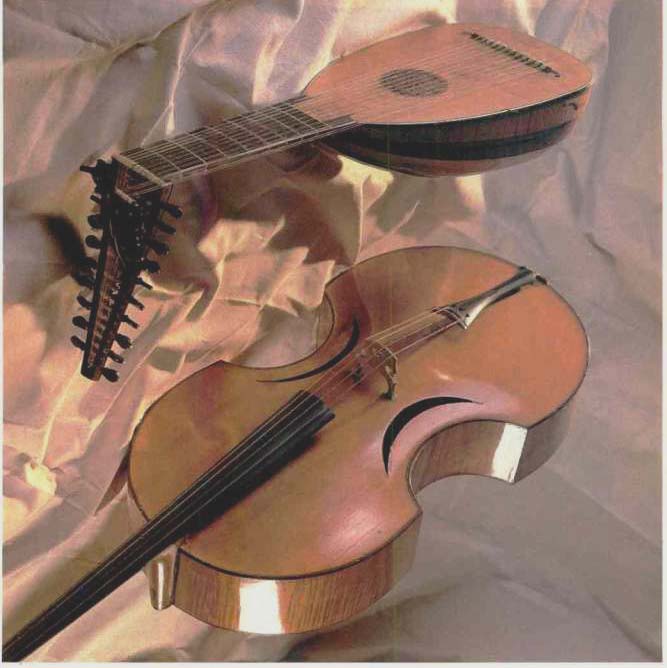
------ Lute: (top) After falling out of fashion in other
European nations during the late 17th century, the lute remained popular
in Germany during the time of J. S. Bach. In fact, Bach's lute suites were
probably composed for an instrument like this one, constructed by Sebastian
Schell of Nuremberg in 1726. Typical of instruments of its period and origin,
this lute includes two chanterelles or single treble strings, and
it is strung in 13 courses (a course is a string or pair of strings designed
for separate tuning). ------ Experimental Cello: (bottom)
Dating from 1828, this cello is an experimental design by Johann Georg
Stauffer of Vienna. Its visual appeal is enhanced by the symmetry resulting
from the identical widths of the upper and lower body segments (technically
known as bouts). Stauffer is also believed to have invented the arpeggione,
a hybrid instrument which is a cross between the cello and the viola da
gamba and for which Schubert wrote a sonata.
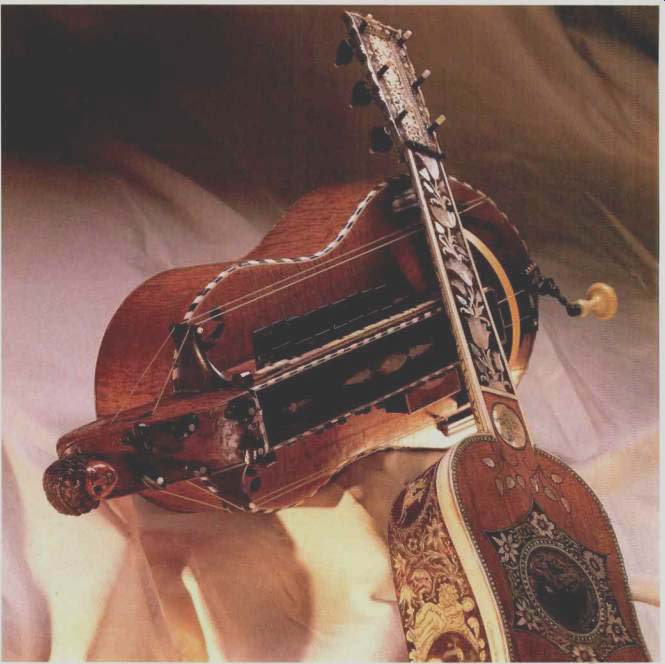
-------- Hurdy-Gurdy: (above, left) In modern usage, the
term hurdy-gurdy refers to a street organ, but, in the 18th century, it
indicated a stringed instrument played by means of a crank . Turning the
crank moved a rosin-coated wheel which continually vibrated six strings.
Two pairs of outer strings, tuned a fifth apart, sounded an accompanying
drone while two middle strings, stopped by a keyboard, played melody.
Hurdygurdies, which became associated with beggars and the blind, are
still in use as folk instruments in Spain and the Balkans. ------- Tielke
Guitar: (above, right)Joachim Tielke was a German luthier, a
maker of plucked and bowed string instruments, and was noted for his
lavishly decorated creations. This guitar, which he built in 1702, is
inlaid with silver, ivory, ebony, mother of pearl, and tortoise shell.
The high cost of Tielke's instruments put them beyond the reach of the
professional musicians of his time, who were anything hut well-to-do.
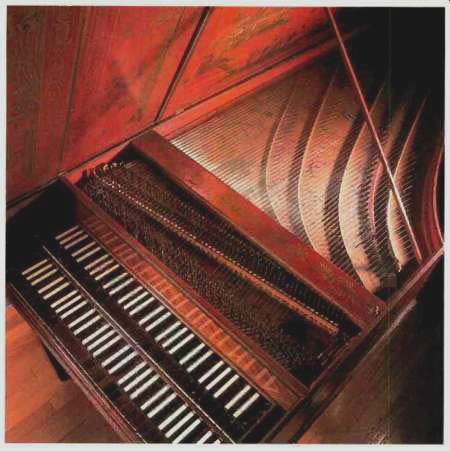
---- Hass Harpsichord In the most elaborate restoration ever undertaken
on a Yale Collection instrument, two men worked eight months to bring
this harpsichord as close to original condition as possible. Constructed
by Johannes A. Hass in 1760, it is the only Baroque German harpsichord
in North or South America. Its distinctive sound, which is less tonally
complex than other harpsichords of the period, may well have been what
J. S. Bash had in mind when composing for the keyboard.

----- Tuba: Brass bands, which are actually composed of
wind and percussion instruments, were an omnipresent phenomenon in 19th-century
America, so when the Yankees marched off to battle the Confederates, instruments
such as this tuba led the way. Although the more modern sousaphone features
a bell that points forward, the business end of this John F. Stratton
tuba, manufactured around 1862, rested on the player's shoulder and was
aimed toward the soldiers following behind.
Though Yale prefers to maintain its instruments in playing condition, not every piece is a candidate for restoration. Work is only begun after determining that an instrument is likely to regain its original voice-or something very close to it. Even after restoration, instruments continue to age. The stewards of the Yale Collection attempt to slow this inevitable process with various countermeasures, most notably meticulous climate control. The instruments are kept in an environment where temperature is held to 68° F and relative humidity to 50%. Water used to humidify the air is deionized to remove mineral elements that Rephann says would settle like fine dust on the instruments, then infiltrate and eventually damage them. Keeping keyboard and string instruments in tune serves to eliminate unnecessary tension on their bodies, and inspection of all the Yale instruments is carried out regularly to reveal any problems before they become serious.
While Rephann holds that the lives of all instruments are shortened by frequent use, several of those in the Yale Collection are carefully and infrequently played. The public is invited to hear them during an annual series of six concerts featuring professional performers. Tickets currently cost $7.50 each and are available for a token $2 to members of the collection's Associates Program. The Yale University Collection of Musical Instruments, located at 15 Hillhouse Avenue in New Haven, is open to the public from 1 to 4 p.m. every Tuesday, Wednesday, and Thursday except during August. Admission is free. For information on membership, concerts, special exhibitions, and publications, write to P.O. Box 2117, New Haven, Conn. 06520.
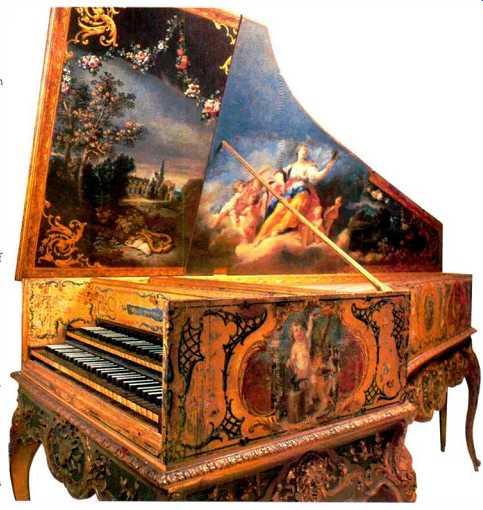
-----Taskin Harpsichord In the early part of this century, the
fact that a harpsichord was built by a noted maker such as Pascal Taskin was
of little interest. Antiquarians of the time altered the one shown here to make
it appear to have been the property of Voltaire's mistress, Mme. du Chatetet
(a respected scientist as well as the famous philosopher's paramour). The original
lid was replaced with another into which were set painted panels; one of these
allegedly pictured the lady's chateau. Since Mme. du Chatetet's liaison with
Voltaire occurred before this harpsichord was even built, the maker's inscription
was also revised from "Fait Par made by) Pascal Taskin 1770" to "Refait
rebuilt] Par Pascal Taskin 1770."
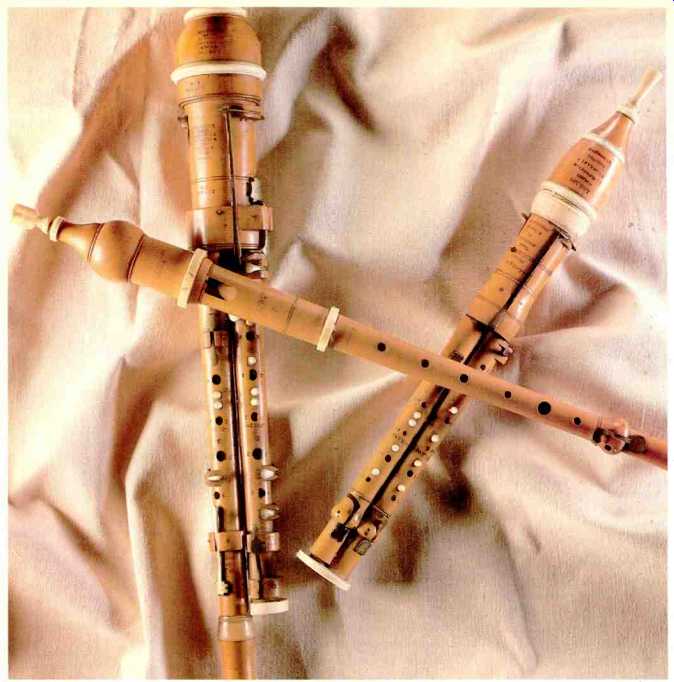
----- The flageolet is a 19th-century instrument that was
probably designed for amateurs. Because it employs a wind cap between its mouthpiece
and body, it doesn't require, that the player control air flow as carefully
as does the recorder, a first cousin to this woodwind. The most common flageolets
were single° barreled instruments, but some, called double flageolets, consisted
of a pair of tubes tuned a third apart. These allowed a single performer to
play in two-part harmony. (Here, the single-barreled flageolet is on top of
two doubles.)
Kits
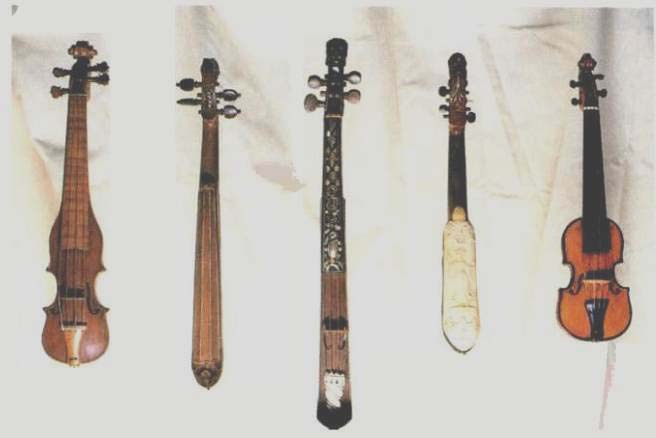
Kits (left), tiny fiddles that first appeared in the 19th century, were
used by dancing masters who carried them in their pockets--hence the French
appellation, pochette. Kits were made in two varieties, with
the most common having narrow, elongated bodies while the rarer kits resembled
miniature violins with long necks. These little instruments were frequently
adorned with elaborate decoration, and even the plainest kits are visually
charming.
Bass Horn and Serpent
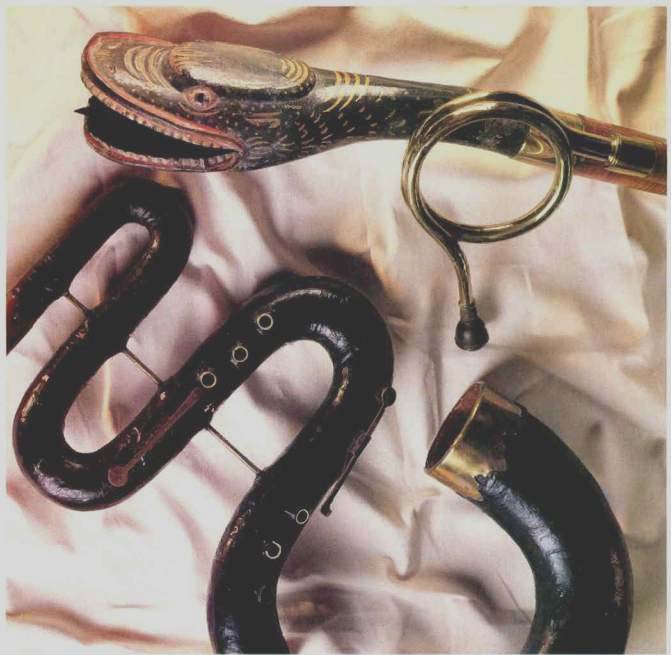
Sometimes called a Russian bassoon, this snake-headed bass horn (top) is neither Russian nor played with a reed. Its body is similar to that of a bassoon, but, like the trumpet, the bass horn is lip vibrated. It is actually a 19th-century variant of an earlier wooden instrument known as the serpent because of its curvilinear shape (bottom). The snake's head adorning the bass horn shown here was a feature of some, but by no means all, such instruments, and it was very likely intended as an allusion to the instrument's ancestry.
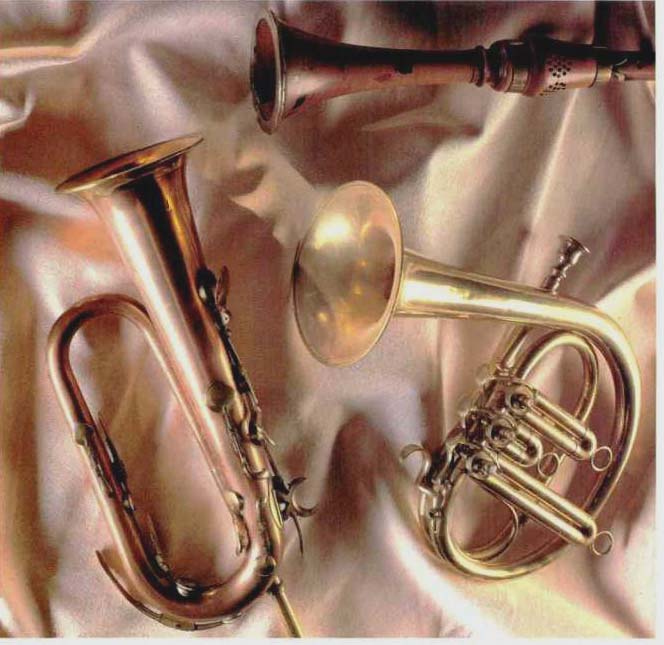
Deutsche Shalmei: This double-reed instrument (top right)
is from the hand of Richard Haka, a late-17th century craftsman who worked
in Amsterdam. Of a genre known as the Deutsche Shalmei, it belongs to
an instrument group introduced to Europe from the Middle East in about
the 12th century. While its place in the music of its time remains uncertain,
the loud, raucous sound it was meant to produce suggests military applications.
Keyed Bugle and Keyed Cornet: During the I9th century, the addition of keys, and later valves, to brass instruments endowed them with a degree of flexibility unavailable in their 18th-century counterparts. Keyed bugles, such as the copper-bodied, brass-trimmed model shown here (bottom left), were eventually replaced by the valved cornet (bottom right), which produced a more desirable tone. Both these instruments were manufactured in New England by Graves & Co.; the bugle was built around 1840 and the cornet some 15 years later.
(adapted from Audio magazine, Feb. 1989)
Also see:
Celebration of Audio's Earliest Years
= = = =